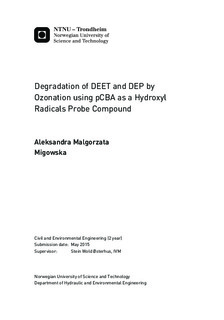Degradation of DEET and DEP by Ozonation using pCBA as a Hydroxyl Radicals Probe Compound
Master thesis
Permanent lenke
http://hdl.handle.net/11250/2350511Utgivelsesdato
2015Metadata
Vis full innførselSamlinger
Sammendrag
The main aim of this thesis was to examine and describe the process of ozonation of two chosen micopollutants present in grey water. These micropollutants are: n,n-diethyl-m-toluamide (DEET) and diethyl phthalate (DEP). In order to assess the fraction of the compound removed by hydroxyl radicals, degradation of one more compound was studied. This compound is para-chlorobenzoic acid (pCBA) which is known for its specific way of reacting with ozone. Namely, pCBA reacts only with hydroxyl radicals, therefore it is commonly applied as a probe compound in order to measure hydroxyl radicals formation. Series of batch experiments was conducted. Each compound s degradation was studies in two types of permeate coming from the pilot plant applying three ozone doses (5 mg/L, 7.5 mg/L, 10mg/L). Additionally, degradation of pCBA in buffered Milli-Q water was performed for ozone dose of 5mg/L. Every experiment was repeated three times. Two studied water types differed in alkalinity and total carbon content. Collected data showed scavenging of ozone by carbonates, therefore, lower removal efficiency in water with higher alkalinity. Moreover, degradation of pCBA and DEET usually proceeded in a similar way with very close removal efficiency values. The lowest removal was noted for DEP. All of studied compound were proved to be removed mostly by radicals. Values of fraction removed by radicals reached 98-100% values. Experiments confirmed described in one of the studies abilities of pCBA to accelerate ozone decomposition. In addition, similar characteristics were observed for DEET as well.
